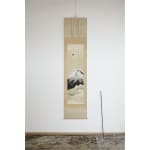Yokoyama Taikan (1868–1958)
Sacred Summit Fuji
Color and gold on silk, hanging scroll
Yokoyama Taikan Registration no. L-2
With a box signed by the artist
Seal: Shokodoshu
125.6 x 35.8 cm
224 x 50.5 cm (overall)
Yokoyama Taikan Registration no. L-2
With a box signed by the artist
Seal: Shokodoshu
125.6 x 35.8 cm
224 x 50.5 cm (overall)
Further images
This painting quintessentially exemplifies Taikan’s artistic sensibility. The subject matter is of Mount Fuji and the rising sun. The distinctive calligraphic style of Taikan’s signature indicates that the artist painted this work some time during the eight-year period between 1940 and 1947. The combination of the snow-capped mountain peering sublimely from the sea of clouds and the sun shining brightly overhead symbolizes Japan as “the land of the gods,” suggesting that Taikan perhaps made this work with the intention of promoting the national prestige during the war rather than in the postwar years.
After losing his home in Ikenohata during the firebombing of Tokyo in March 1945, Taikan was evacuated to the banks of Lake Yamanakako, and then moved to a temporary home in Atami Izusan, lived for several years and enjoyed spectacular views of Mount Fuji daily. Taikan’s favorite view of Fuji was that of the mountain rising across Lake Ashinoko as seen from atop a mountain with an elevation of 1011 meters in Hakone, Kanagawa Prefecture. Because of this, the mountain in Hakone came to be named “Mount Taikan.”
This work has the simple composition of the sun, Mount Fuji, and clouds. The sea of clouds in front of the summit looks like a range of overlapping mountains, while the formation at the back appears like lingering auspicious clouds. Though this work is one of many commissioned paintings of Mount Fuji by Taikan, the distinctive innovativeness devoted here is worthy of our attention. Also unusual is the vertical composition of this painting. Taikan generally rendered Mount Fuji in wide, horizontal format, however, in the hanging scroll here, he created a sense of depth and distance, making it unique among his many Mount Fuji paintings.
Yokoyama Taikan (nihonga painter; 1868−1958)
Ibaraki-born nihonga painter. His real name is Hidemaro. Became a dicsiple of Okakura Tenshin and Hashimoto Gaho. Assisted Tenshin in the founding of the Japan Art Institute (Nihon Bijutsuin), and played an active role as the core member. Also appointed to a jury in the Ministry of Education Art Exhibition (Bunten). Played an influential role in the modern nihonga history from Meiji to Postwar era. Designated as an Imperial Court Artist and a Person of Cultural Merit, and received the Order of Culture.
After losing his home in Ikenohata during the firebombing of Tokyo in March 1945, Taikan was evacuated to the banks of Lake Yamanakako, and then moved to a temporary home in Atami Izusan, lived for several years and enjoyed spectacular views of Mount Fuji daily. Taikan’s favorite view of Fuji was that of the mountain rising across Lake Ashinoko as seen from atop a mountain with an elevation of 1011 meters in Hakone, Kanagawa Prefecture. Because of this, the mountain in Hakone came to be named “Mount Taikan.”
This work has the simple composition of the sun, Mount Fuji, and clouds. The sea of clouds in front of the summit looks like a range of overlapping mountains, while the formation at the back appears like lingering auspicious clouds. Though this work is one of many commissioned paintings of Mount Fuji by Taikan, the distinctive innovativeness devoted here is worthy of our attention. Also unusual is the vertical composition of this painting. Taikan generally rendered Mount Fuji in wide, horizontal format, however, in the hanging scroll here, he created a sense of depth and distance, making it unique among his many Mount Fuji paintings.
Yokoyama Taikan (nihonga painter; 1868−1958)
Ibaraki-born nihonga painter. His real name is Hidemaro. Became a dicsiple of Okakura Tenshin and Hashimoto Gaho. Assisted Tenshin in the founding of the Japan Art Institute (Nihon Bijutsuin), and played an active role as the core member. Also appointed to a jury in the Ministry of Education Art Exhibition (Bunten). Played an influential role in the modern nihonga history from Meiji to Postwar era. Designated as an Imperial Court Artist and a Person of Cultural Merit, and received the Order of Culture.











